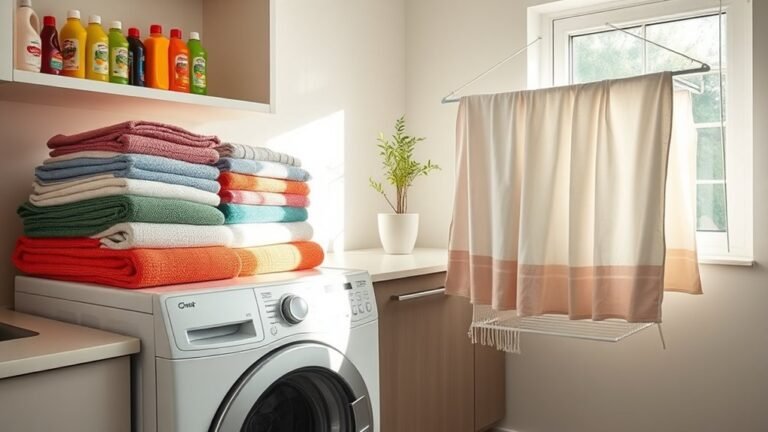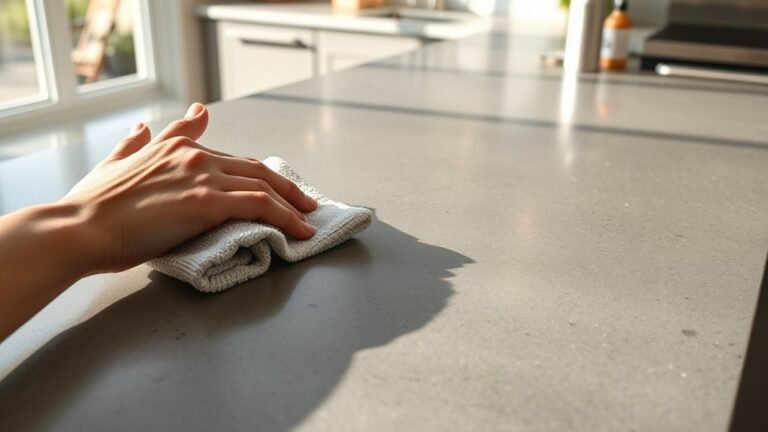How to Remove Laminate From Range Hood
To remove laminate from your range hood, start by unplugging it for safety and clearing the area. Use a heat gun or hairdryer to warm the laminate, softening the adhesive beneath. Then, gently slide a putty knife under the edges to peel it off, being careful not to damage the surface. Clean any leftover glue with rubbing alcohol and sand the area smooth to prep for refinishing. Keep following these steps, and you’ll discover how to get a flawless result.
Tools and Materials Needed

To remove laminate from your range hood effectively, you’ll need a few essential tools and materials. First, gather a heat gun or hairdryer to soften the adhesive, which is vital for most removal techniques. You’ll also want a putty knife or scraper to gently lift the laminate without damaging the surface underneath. Depending on the laminate types—whether paper-based or plastic—you might need adhesive remover or rubbing alcohol to clean residual glue. Gloves and safety glasses are smart for protecting yourself during the process. Having a clean cloth or sponge ready will help wipe away debris as you work. With these tools in hand, you’re set to tackle the laminate removal efficiently, freeing your range hood from unwanted coverings and allowing for a fresh new look.
Preparing the Work Area
Before you begin removing the laminate, make sure your work area is clean and well-ventilated. Proper work area organization sets you up for a smooth, stress-free project. Clear space around the range hood, and use protective coverings to shield counters and appliances from dust or debris. This way, you keep freedom from mess and damage.
| Task | Tipp |
|---|---|
| Clear counters | Remove all items |
| Ventilation | Open windows or use fans |
| Floor protection | Lay down drop cloths |
| Tool placement | Keep tools within reach |
Prepping your space right gives you control and freedom to work efficiently without distractions or hazards.
Safety Precautions Before You Start

Before you begin removing the laminate, make sure to turn off the power and unplug the range hood to avoid any electrical hazards. You’ll also want to wear protective gear like gloves and safety glasses to keep yourself safe. Finally, ventilate the area well to prevent inhaling any dust or fumes during the process.
Power Off and Unplug
Although it might seem obvious, you should always power off and unplug your range hood before starting any work. Putting safety first isn’t just a suggestion—it’s vital to avoid electrical hazards. Taking these electrical precautions gives you the freedom to work confidently and protect yourself.
Here’s your quick checklist:
- Locate the power switch or circuit breaker and turn off the range hood’s electricity.
- Unplug the unit from the wall outlet to guarantee no power is flowing.
- Double-check by attempting to turn the range hood on—nothing should happen.
Wear Protective Gear
Since you’ll be handling tools and potentially sharp edges when removing laminate from your range hood, wearing protective gear is essential to keep yourself safe. Slip on a good pair of protective gloves to guard your hands from cuts and scrapes. These gloves will give you the confidence to work freely without worrying about minor injuries. Don’t forget safety goggles—they shield your eyes from dust, debris, and any unexpected splinters that might fly off during the removal process. Protecting your eyes helps you stay focused and unbothered, letting you work with ease and freedom. Taking these simple safety steps means you can plunge into the job boldly, knowing you’re well-protected. It’s all about working smart and safe to get that laminate off smoothly.
Ventilate the Area
Two simple steps can make a big difference when you’re removing laminate from your range hood: ventilate the area well and keep fresh air flowing. Proper ventilation helps maintain air quality, preventing fumes or dust from lingering.
Here are three ventilation tips to free up your workspace:
- Open windows and doors to create cross-ventilation, allowing fresh air to circulate and push out contaminants.
- Use a fan positioned near the work area to direct dust and fumes outside quickly.
- If available, turn on your kitchen’s exhaust fan to boost airflow and reduce airborne particles.
These steps help guarantee you’re breathing easy while working, letting you focus on the job without worrying about harmful buildup. Good air quality means a safer, more comfortable environment for your project.
Heating the Laminate for Easier Removal

A bit of heat can make removing laminate from your range hood much easier by softening the adhesive underneath. Depending on the laminate types used, some adhesives respond better to gentle warmth, so choosing the right heating methods is key. You can use a heat gun or a hairdryer set on medium heat—both provide controlled warmth without damaging the surface. Hold the heat source a few inches away, moving it steadily to avoid burning or warping the laminate. Keep heating the area for a few minutes until the laminate feels pliable to the touch. This step loosens the bond, giving you the freedom to peel the laminate off with less effort and risk of damage. Always stay patient and avoid overheating.
Using a Putty Knife to Peel Off Laminate
You’ll want to pick a putty knife with a thin, flexible blade to avoid damaging the surface beneath. Before you start peeling, soften the laminate edges with heat to make lifting easier. Then, gently slide the knife under the laminate and work it off carefully to prevent any tearing or gouging.
Choosing the Right Putty Knife
Selecting the right putty knife is key to peeling off laminate without damaging your range hood. You want a tool that’s just right—neither too sharp nor too dull. Here’s how to pick the perfect putty knife based on putty knife types and putty knife sizes:
- Type: Choose a flexible stainless steel blade for smooth, controlled prying. Avoid rigid or overly sharp types that can gouge the surface.
- Size: Start with a narrow blade (1-2 inches) for precision in tight spots, then switch to a wider blade (3-4 inches) to cover larger areas efficiently.
- Handle: Opt for a comfortable grip that lets you apply steady pressure without fatigue.
With the right putty knife, you’ll enjoy the freedom to work confidently and protect your range hood’s finish.
Softening Laminate Edges
Once you have the right putty knife in hand, it’s time to gently soften the laminate edges before peeling. Different laminate types and their edge finishing can affect how stubborn the edges are. Start by sliding the putty knife carefully under the edge, applying slight pressure to loosen the bond without damaging the surface beneath. This softening step is essential—it helps you avoid tearing or cracking the laminate as you work. Focus on the corners and seams where the edge finishing is often reinforced. Take your time; rushing can lead to chipping or uneven peeling. By patiently easing the laminate edges, you set yourself up for a smoother, cleaner removal process that preserves the integrity of your range hood’s underlying structure.
Safe Peeling Techniques
Carefully peeling off laminate with a putty knife requires steady hands and patience. Mastering safe peeling techniques guarantees you remove the laminate cleanly without damaging the range hood beneath. Here’s how you can confidently approach laminate removal:
- Start at a corner – Gently slide the putty knife under the laminate edge, lifting it slowly to avoid tearing or gouging the surface.
- Apply consistent pressure – Use steady, even force to peel the laminate back in small sections, preventing sudden snaps or breaks.
- Work methodically – Move along the surface gradually, keeping the blade close to the laminate to separate it cleanly from the adhesive.
Applying Adhesive Remover for Stubborn Areas
Although most of the laminate will come off easily, you might find some stubborn adhesive residue that won’t budge with just scraping. That’s when applying adhesive remover becomes your go-to. Start by selecting a remover suited for your range hood’s material, then apply it directly to those tough spots. Let it sit for a few minutes to soften the adhesive. Using a plastic scraper or cloth, gently rub the area to lift the residue without damaging the surface. These adhesive remover techniques are effective stubborn area solutions that give you control and freedom from sticky messes. Remember, patience is key—repeat the process if needed until the surface feels clean and smooth, ready for the next steps in your project.
Cleaning Residue After Laminate Removal
After tackling the stubborn adhesive with remover, you’ll likely notice some leftover residue on your range hood’s surface. Don’t worry—residue removal is a key step toward a clean finish and freedom from sticky messes. For effective adhesive cleanup, follow these steps:
Leftover adhesive residue is common after removal—clean it thoroughly for a spotless, sticky-free range hood finish.
- Use a soft cloth soaked in warm, soapy water to gently wipe away loosened residue without damaging the surface.
- Apply a small amount of rubbing alcohol or vinegar on a clean cloth to tackle tougher spots, letting it sit briefly before wiping.
- Rinse with a damp cloth and dry thoroughly to guarantee no cleaner remains that might attract dirt or cause damage.
Sanding the Surface Smooth
Start smoothing the range hood’s surface by sanding it with fine-grit sandpaper. This step is essential for effective surface preparation, ensuring any leftover laminate residue or rough patches are removed. Use gentle, even pressure and circular motions to avoid gouging the metal or wood beneath. Mastering sanding techniques here gives you freedom to create a flawless base for whatever finish you choose next. Don’t rush—take your time to achieve a uniform smoothness that feels consistent to the touch. If needed, switch to a slightly coarser grit first to tackle stubborn areas, then return to fine grit for the final pass. Proper sanding not only improves adhesion for new finishes but also restores the range hood’s sleek appearance, setting you up for success in your renovation project.
Preparing the Range Hood for New Finish
Get your range hood ready for its new finish by thoroughly cleaning the surface to remove all dust, grease, and sanding residue. This step is essential to guarantee your new coat adheres perfectly, especially after removing old laminate finishes. Here’s how you can prep like a pro:
- Wipe down the range hood with a degreaser to eliminate any lingering kitchen grime.
- Use a damp cloth to remove all sanding dust, making sure no particles remain.
- Let the surface dry completely before applying any primer or paint.
Taking these simple steps frees you from imperfections and preps your range hood for a smooth, lasting finish. You’re one step closer to revitalizing your kitchen with confidence and style!
Häufig gestellte Fragen
Can Laminate Removal Damage My Range Hood’S Metal Surface?
You might worry that laminate removal could damage your range hood’s metal surface, and that’s a valid concern. To guarantee metal surface protection, you’ll want to use gentle laminate removal techniques, like applying heat or adhesive remover carefully. Avoid scraping too hard or using harsh chemicals, so you don’t scratch or corrode the metal underneath. Taking your time and being cautious helps keep your range hood looking great while freeing it from laminate.
How Long Does Laminate Removal Typically Take?
You’d think peeling off laminate is a quick magic trick, right? Well, time estimates vary depending on your removal techniques and patience level. If you’re careful with heat guns or adhesive removers, it can take anywhere from 30 minutes to a few hours. Don’t rush; freedom from stubborn laminate means embracing the process. So, gear up, and remember—it’s not just about speed but preserving your surface’s integrity while reclaiming your kitchen’s style.
Is It Safe to Use a Heat Gun Instead of a Hairdryer?
You can use a heat gun instead of a hairdryer, but you’ve got to prioritize heat gun safety. Heat guns are more efficient at loosening adhesives quickly, which can speed up your project, but they also get much hotter, increasing the risk of burns or damaging surfaces if you’re not careful. If you choose this route, keep the gun moving, maintain a safe distance, and wear protective gear to stay safe while enjoying the freedom to work faster.
Can I Reuse the Removed Laminate for Another Project?
You might think laminate’s as stubborn as a mule, but with the right laminate repurposing tips, you can totally give it new life! Don’t toss that removed laminate—get creative! Use it for funky wall art, drawer liners, or even unique coasters. The freedom to transform old materials into something fresh and personal is what creative project ideas are all about. So, yes, you can definitely reuse that laminate and release your DIY spirit!
What Finishes Work Best After Laminate Removal on a Range Hood?
After removing laminate, you’ll want to focus on surface preparation to get a smooth base. Sand the area thoroughly and clean off any residue, so paint options like high-heat resistant enamel or appliance epoxy stick well. These finishes not only protect but add style, giving you freedom to customize your range hood’s look. Don’t rush prep—it makes all the difference in how your paint job holds up over time.






